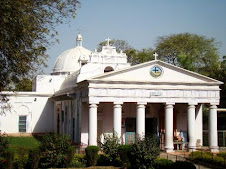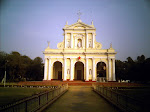The present stately Cathedral is dedicated to Our Lady of the Immaculate Conception. The construction work was begun in 1846 by Rt. Rev. Dr. Joseph Anthony Borghi, O.C., the Vicar- Apostolic of Tibet-Hindustan and was solemnly blessed by him on January 1, 1848. The architect of the Cathedral was Rev. Fr. Bonaventure, an Italian from Florence. In 1857 the Church was extensively damaged during the First War of Independence. The magnificent High Altar which was donated by Messrs John & Co. was consecrated with great solemnity by the Most Rev. Dr. Gentili, O.C., in December 1899. The beauty of the Church was further enhanced by paving its floor with white and black marble slabs and replacing the six plaster altars at the side with marble ones. Cathedral parish is today adorned with seven religious houses and fourteen institutions.
Agra Archdiocese consists of the following districts in Uttar Pradesh: Agra, Aligarh, Auraiya, Budaun, Bulandshahr, Etah, Etawah, Farrukabad, Firozabad, Gautambudha Nagar, Hathras, Kannauj, Mainpuri, Mathura and in
The history of the Agra Archdiocese under the Capuchins was closely linked with their work in Tibet. Early in 1708, four Capuchins, starting from Kathmandu, reached Lhasa after two months. More Capuchins followed them and took up their residence at Lhasa until April 20, 1745, when, owing to relentless persecution by the Tibetan Priesthood, they had to leave Tibet, and return to Nepal. Thus the capuchin Church work in Lhasa came to an end. But the Church work continued its existence in Nepal until 1768.
The whole chain of Capuchin stations, embracing the greater part of North India from Chandernagore to Lhasa, from Sind to Bengal, from the Himalayas to Narbada river, now the Diocese of Ajmer - Jaipur, Allahabad, Indore, Jhansi, Lahore, Lucknow, Meerut, Patna, Varanasi, Delhi, Jalandar, Simla - Chandigarh, Bijnor and Jammu & Kashmir, (formerly Rawalpindi) all came to be known as the Tibet Hindustan Church work. The Cathedrals of Agra, Ajmer, Allahabad, Delhi, Lahore (before the new one), Madras, Patna and Simla, are symbols and monuments of the untiring zeal of the Capuchins for the extension of the faith and the progress of the Catholic Church in India. The prefecture Apostolic of Tibet-Hindustan was in 1820, constituted into the Vicaritae Apostolic of Agra, with Msgr. Maria Zenobio Benucci, ofm cap. as its first Vicar Apostolic, who was succeeded by Msgrs. Anthony Pezzoni and Anthony Borghi. In 1845, the Agra Mission was divided into two separate vicariates: Agra and Patna.In 1846 the Kingdom of Tibet was entrusted to the Society of the Foreign Missions. In 1861 the districts of Allahabad, Oudh, Kanpur, Bundlekhand, Sagar and Bhopal were added to the Patna Vicariate, and in 1880 the districts of Kumaon and Almorah. In the same year, the Vicariate Apostolic of the Punjab was erected and separated from Agra. Finally in 1886 when the Catholic Hierarchy of India was established, the Vicariate Apostolic of Agra became a Metropolitan See from which the Prefecture Apostolic of Rajputana sprung in 1913, and in 1956, the nine northern districts were formed into the Diocese of Meerut.



